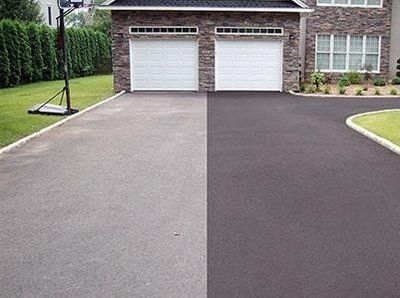Unleash the Potential: Regrading and Asphalt Sealing for Commercial Rooms
Hot Mix Asphalt: A Sustainable Remedy for Sidewalk
Hot Mix Asphalt (HMA) has actually emerged as a leading sustainable choice for sidewalk solutions, using a myriad of environmental advantages and ingenious technologies. As the demand for eco-friendly construction techniques grows, checking out the subtleties of HMA's sustainability can give beneficial understandings into the future of pavement options.
Environmental Benefits of Warm Mix Asphalt

Furthermore, Warm Mix Asphalt assists to alleviate urban heat island impacts. Its dark color soaks up sunlight, minimizing the quantity of warmth reflected back into the environment compared to lighter-colored pavements. This can decrease ambient temperatures in city areas, lowering the need for air conditioning and inevitably decreasing power consumption.
Furthermore, Warm Mix Asphalt adds to enhanced stormwater monitoring. Its permeable nature allows water to infiltrate the pavement and reenergize groundwater materials, reducing runoff and the threat of flooding. These ecological benefits make Warm Mix Asphalt a lasting choice for leading freeways and roadways.
Energy Performance in HMA Manufacturing
Is energy efficiency an important consider the production of Warm Mix Asphalt (HMA)? Absolutely. Power plays a significant duty in the manufacturing of HMA, affecting both cost and ecological sustainability. One essential aspect of power efficiency in HMA manufacturing is making use of warm mix asphalt (WMA) technologies (angled parking). WMA enables the mixing and placement of asphalt at lower temperatures contrasted to traditional warm mix asphalt, resulting in minimized power usage throughout manufacturing. This process not just decreases gas use however additionally reduces greenhouse gas exhausts, making it an extra eco friendly option.
Moreover, advancements in plant innovations have actually brought about more energy-efficient HMA production procedures. Modern plants are created with attributes like recycled asphalt pavement (RAP) processing capabilities, reliable burner systems, and boosted insulation, all adding to energy cost savings. By maximizing energy usage in HMA manufacturing, the industry can reduce its carbon footprint while keeping top notch sidewalk products. Energy performance is, for that reason, a crucial factor to consider in making sure the sustainability of Hot Mix Asphalt manufacturing.
Recyclability of Warm Mix Asphalt
The recyclability of Warm Mix Asphalt (HMA) is an essential aspect of its sustainability and long-lasting environmental impact. HMA is just one of the most recycled products in the USA, with over 100 million lots of recovered asphalt pavement (RAP) being recycled annually in new pavement building and construction. Reusing HMA supplies several ecological benefits, such as decreasing the requirement for virgin materials, reducing power intake throughout production, and lowering the quantity of waste sent out to garbage dumps.
The procedure of recycling HMA involves milling the existing pavement, crushing it right into smaller sized pieces, and mixing it with new aggregate and asphalt binder to develop a recycled mix. This recycled mix can often perform as well have a peek here as or perhaps much better than standard HMA, while requiring less basic materials and generating reduced greenhouse gas emissions. By including RAP right into brand-new pavement jobs, road agencies can conserve natural deposits, lower expenses, and lessen the environmental footprint of road construction and upkeep tasks. Overall, the recyclability of HMA plays a significant duty in advertising lasting techniques within the pavement industry.

Long-Term Efficiency of HMA
Asphalt sidewalks demonstrate sturdiness and durability over an extensive period, reflecting the lasting efficiency of Hot Mix Asphalt (HMA) Furthermore, developments in HMA modern technology, such as the usage of polymer-modified binders and cozy mix asphalt, have actually even more improved the durability and longevity of HMA pavements. By prioritizing top quality building and maintenance methods, HMA proceeds to show itself as a sustainable and economical option for lasting sidewalk infrastructure.

HMA: Toughness and Sustainability
Showing both resilience and sustainability, Warm Mix Asphalt (HMA) has actually become a keystone in the construction of lasting pavement infrastructures - angled parking. HMA's sturdiness comes from its capability to endure hefty tons, rough climate condition, and high web traffic quantities, making it a dependable choice for roadways, freeways, and airport terminal paths. The structure of HMA, which generally consists of aggregates, binder, and filler, plays a vital duty in enhancing its durability and resistance to tear and use
In addition, HMA's sustainability depends on its recyclability and energy-efficient production procedure. The capability to recycle recovered asphalt pavement (RAP) in new HMA mixtures decreases the demand for virgin materials and lessens the ecological effect of pavement construction and upkeep. In addition, the energy performance of generating HMA depends on its reduced blending temperatures contrasted to other sidewalk materials, bring about decreased energy intake and greenhouse gas discharges.
Conclusion
In final thought, hot mix asphalt (HMA) supplies a lasting remedy for sidewalk with its eco pleasant characteristics. HMA's recyclability, power performance in manufacturing, and lasting longevity make it an environment-friendly choice for road building and construction.
HMA is one of the most recycled materials in the United States, with over 100 million tons of redeemed asphalt sidewalk (RAP) being reused yearly in new sidewalk construction.The procedure of recycling HMA entails grating the existing pavement, squashing it into smaller sized pieces, and blending it with new accumulation and asphalt binder to produce a recycled mix.Asphalt sidewalks demonstrate durability and durability over an extended duration, reflecting the lasting performance of Warm Mix Asphalt (HMA) Additionally, improvements in HMA technology, such as the usage of polymer-modified binders and warm mix asphalt, have actually additionally boosted the resilience and long life of HMA pavements. The capability to recycle recovered asphalt sidewalk (RAP) in brand-new HMA blends reduces the demand for virgin materials and minimizes the environmental influence go to this site of pavement More hints building and upkeep.